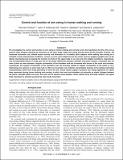| dc.contributor.author | Pontzer, Herman | |
| dc.contributor.author | Holloway, John H. III | |
| dc.contributor.author | Raichlen, David A. | |
| dc.contributor.author | Lieberman, Daniel Eric | |
| dc.date.accessioned | 2010-02-18T20:19:02Z | |
| dc.date.issued | 2009 | |
| dc.identifier.citation | Pontzer, Herman, John H. Holloway III, David A. Raichlen, and Daniel E. Lieberman. 2009. Control and function of arm swing in human walking and running. Journal of Experimental Biology 212: 523-534. | en_US |
| dc.identifier.issn | 0022-0949 | en_US |
| dc.identifier.uri | http://nrs.harvard.edu/urn-3:HUL.InstRepos:3660591 | |
| dc.description.abstract | We investigated the control and function of arm swing in human walking and running to test the hypothesis that the arms act as
passive mass dampers powered by movement of the lower body, rather than being actively driven by the shoulder muscles. We
measured locomotor cost, deltoid muscle activity and kinematics in 10 healthy adult subjects while walking and running on a
treadmill in three experimental conditions: control; no arms (arms folded across the chest); and arm weights (weights worn at the
elbow). Decreasing and increasing the moment of inertia of the upper body in no arms and arm weights conditions, respectively,
had corresponding effects on head yaw and on the phase differences between shoulder and pelvis rotation, consistent with the
view of arms as mass dampers. Angular acceleration of the shoulders and arm increased with torsion of the trunk and shoulder,
respectively, but angular acceleration of the shoulders was not inversely related to angular acceleration of the pelvis or arm.
Restricting arm swing in no arms trials had no effect on locomotor cost. Anterior and posterior portions of the deltoid contracted
simultaneously rather than firing alternately to drive the arm. These results support a passive arm swing hypothesis for upper
body movement during human walking and running, in which the trunk and shoulders act primarily as elastic linkages between
the pelvis, shoulder girdle and arms, the arms act as passive mass dampers which reduce torso and head rotation, and upper
body movement is primarily powered by lower body movement. | en_US |
| dc.description.sponsorship | Anthropology | en_US |
| dc.description.sponsorship | Human Evolutionary Biology | en_US |
| dc.language.iso | en_US | en_US |
| dc.publisher | The Company of Biologists | en_US |
| dc.relation.isversionof | doi:10.1242/jeb.024927 | en_US |
| dc.relation.hasversion | http://www.fas.harvard.edu/~skeleton/pdfs/2009d.pdf | en_US |
| dash.license | LAA | |
| dc.subject | arm swing | en_US |
| dc.subject | walking | en_US |
| dc.subject | running | en_US |
| dc.subject | passive dynamics | en_US |
| dc.subject | tuned mass dampers | en_US |
| dc.title | Control and Function of Arm Swing in Human Walking and Running | en_US |
| dc.type | Journal Article | en_US |
| dc.description.version | Version of Record | en_US |
| dc.relation.journal | Journal of Experimental Biology | en_US |
| dash.depositing.author | Lieberman, Daniel Eric | |
| dc.date.available | 2010-02-18T20:19:02Z | |
| dc.identifier.doi | 10.1242/jeb.024927 | * |
| dash.contributor.affiliated | Lieberman, Daniel | |
| dc.identifier.orcid | 0000-0002-6194-9127 | |


